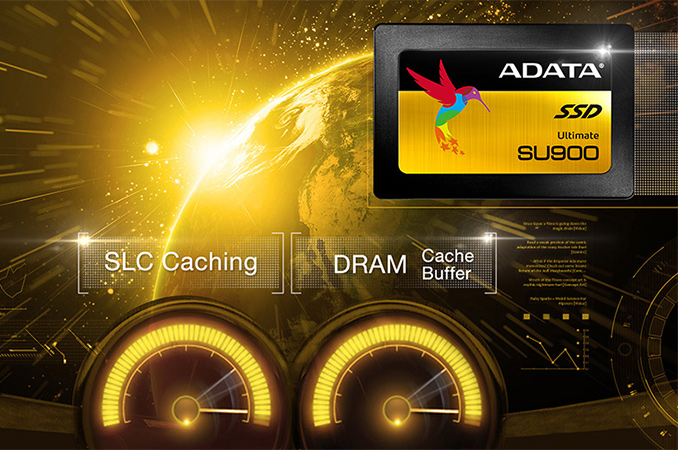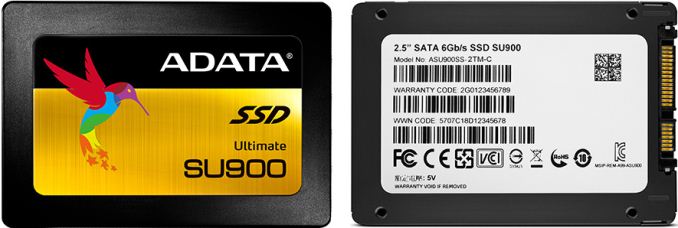ADATA Announces Ultimate SU900: 3D MLC NAND, SMI Controller, SATA
by Anton Shilov on December 16, 2016 2:00 PM EST
ADATA has introduced its second family of consumer SSDs featuring 3D MLC NAND memory. The Ultimate SU900 drive is claimed to be designed for users who value extended reliability that 3D MLC flash promises to offer under a SATA interface. Apart from usual capacities from 256 to 1 TB, the new lineup also includes a 2 TB model.
It is no secret that suppliers of SSDs are engaged into a price war in the recent years in a bid to maximize their sales and replace HDDs from various market segments. As a result, the progress made by SSD controllers has enabled makers of drives to use TLC NAND for consumer and then enterprise-grade SSDs. In the recent quarters, TLC-based SSDs made by various independent manufacturers demonstrated their viability in terms of costs and endurance and it was not surprising that when producers of flash memory began their transition to 3D NAND, they prioritized ramp of TLC-type flash memory. While performance of SSDs powered by TLC satisfies a lot of users and their reliability and durability cause no problems for SSD makers, there are people who demand a bit higher performance and a better endurance than TLC-based drives can provide. Particularly for such people, ADATA introduced its new Ultimate SU900 family of SSDs based on Micron’s (IMFT’s) 3D MLC NAND. The new drives are the company’s second lineup of SSDs to use 3D MLC NAND after the high-end XPG SX8000 launched in late September.
The ADATA Ultimate SU900 family of 2.5”/7 mm SSDs consists of four models with 256 GB, 512 GB, 1 TB and 2 TB capacity. The drives are based on Silicon Motion’s SM2258 controller, which has four NAND flash channels, LDPC ECC technology and supports a DRAM buffer as well as pseudo-SLC (pSLC) caching in order to maximize SSD performance.
Speaking of performance, ADATA says that the Ultimate SU900 SSDs support sequential read speed of up to 560 MB/s as well as sequential write speed of up to 525MB/s when pseudo-SLC caching is used. The manufacturer traditionally does not disclose random performance of its drives as well as their power consumption, but the SM2258 controller is rated up to 90,000 read IOPS and up to 80,000 write IOPS.
| ADATA Ultimate SU900 Specifications | ||||
| Capacity | 256 GB | 512 GB | 1 TB | 2 TB |
| Model Number | ASU900SS-256GM-C | ASU900SS-512GM-C | ASU900SS-1TM-C | ASU900SS-2TM-C |
| Controller | Silicon Motion SM2258 | |||
| NAND Flash | 3D MLC NAND | |||
| Sequential Read | 560 MB/s | |||
| Sequential Write | 520 MB/s | 525 MB/s | ||
| Random Read IOPS | Up to 90K IOPS (taken from SM2258, actual will be lower) | |||
| Random Write IOPS | Up to 80K IOPS (taken from SM2258, actual will be lower) | |||
| Pseudo-SLC Caching | Supported | |||
| DRAM Buffer | Yes, capacity unknown | |||
| TCG Opal Encryption | No | |||
| Power Management | DevSleep | |||
| Warranty | 5 years | |||
| MTBF | 2,000,000 hours | |||
| MSRP | $117.99 | $219.99 | $409.99 | Unknown |
The Ultimate SU900 SSDs will be ADATA’s most advanced SATA 6 Gbps SSDs to date and because their performance is higher compared to that offered by ADATA’s Premier Pro SP920, the manufacturer will likely position them accordingly. Moreover, the inclusion of a 2 TB model into the product line emphasizes that the drives are aimed at both general consumers and users that need a lot of flash storage space. Given such positioning, it is a little strange that ADATA does not disclose TBW ratings of its Ultimate SU900 drives.
ADATA’s Ultimate SU900 SSDs will be available in the coming weeks. MSRPs for 256 GB, 512 GB and 1 TB drives will be $117.99, $219.99 and $409.99, respectively. The 2 TB configuration will be available a little later and will naturally cost more. Like the rest of ADATA’s premium SSDs featuring MLC flash memory, the Ultimate SU900 will be offered with a five-year warranty and with MTBF rating of 2 million hours.
| ADATA Ultimate SU800 and Ultimate SU900 MSRP Comparison | |||||
| 128 GB | 256 GB | 512 GB | 1 TB | 2 TB | |
| SU800 | $59.99 | $79.99 | $139.99 | $269.99 | - |
| SU900 | - | $117.99 | $219.99 | $409.99 | unknown |
Related Reading:
- ADATA Launches XPG SX8000: High-End M.2 NVMe SSD Featuring 3D MLC NAND
- ADATA Introduces Ultimate SU800 SSD: SMI Controller, 3D NAND, SATA Interface
- ADATA Ultimate SU800 SSDs in M.2 Announced: Entry-Level 3D NAND SSDs for Laptops
- ADATA Launches the SD700 External SSD: Dust, Water and Shock Resistant (with 3D NAND)
Source: ADATA

















12 Comments
View All Comments
dgingeri - Friday, December 16, 2016 - link
2,000,000 hour MTBF? That's enterprise drive level ratings. Is that at a 24X7 duty cycle?fanofanand - Friday, December 16, 2016 - link
SSD endurance is typicaly expressed in drive writes per day. As SSDs don't "spin up" the MTBF means nothing to these drives. It's silly really. This drive is $16 less than an 850 Pro, so they will sell precisely zero to informed customers. Stupid pricing for what appears to otherwise be a decent product if you still need SATA. If the pricing was aggressive that 2TB would find a home in many PS4s I'm guessing.Samus - Saturday, December 17, 2016 - link
If anything, it actually shows how clueless ADATA is. They are a 3rd tier SSD vendor, charging tier 1 prices. They don't make controllers, NAND or firmware. They have high failure rates (I can't count how many SP500's I've mailed in) at least their warranty process is fairly quick with a 3-4 day turn around. I don't know who anybody buys their products.fanofanand - Friday, December 16, 2016 - link
Sorry for the 2nd post, but without encryption nobody would put one of these in a datacenter. This is a very consumer-focused device.MrSpadge - Monday, December 19, 2016 - link
Doesn't matter. There is no mechanical wear from startup, like in an HDD, and this thing is not getting hot (i.e. it doesn't profit from cooling cycles).shabby - Friday, December 16, 2016 - link
Nothing ultimate about sata3 speeds anymore.LordanSS - Friday, December 16, 2016 - link
This is really getting old...For client usage, queue depths around 1-3, you get *NO* benefit for using a M.2 PCIe SSD over a SATA3 one. Transfer and use of very large files (talking GigaBytes here) see improvement, but that's all.
Hell, I've installed programs and games on a RAMDrive in my computer and I couldn't notice a difference between that and my 850 EVO. Maybe if I had a stopwatch going I'd detect a couple tenths of a second difference between game loads.
Lolimaster - Saturday, December 17, 2016 - link
Games are not really optimized for the hyper speed of a ram drive or even an SSD even at loading.But yes, unless you move really huge chunks of data (100GB+), work editting 4k HD videos there's literally 0 benefit between sata ssd and nvme pci-e top of of the line SSD.
shabby - Monday, December 19, 2016 - link
I take it 640k is enough memory for you too?Hrel - Sunday, December 18, 2016 - link
Why do they list a MTBF? Anton do you, or anyone else over there, know why that's even listed?